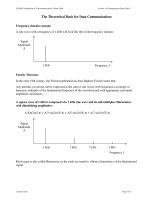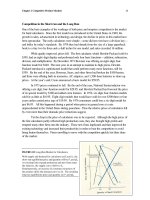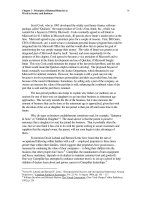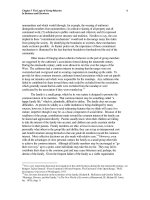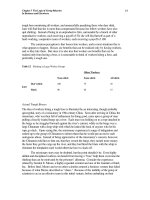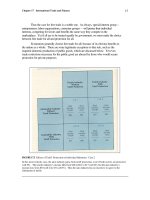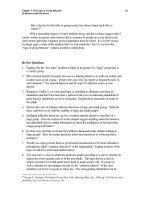RADIATION PHYSICS FOR MEDICAL PHYSISCISTS ppt
Bạn đang xem bản rút gọn của tài liệu. Xem và tải ngay bản đầy đủ của tài liệu tại đây (12.33 MB, 457 trang )
+$ '$0#; 4& -404*-0 2# 1$#-0 6+G;-; 2# -41$#-0 $2*-2$$:-2* :$ :4#! 1C0@-#-;-60-2:G 2#
#G21-7 +$G 0-$ @ @+$ :4;;:4#; 4& &:42@-$: :$;$:+ -2 6+G;-;! -404*G! +$1-;@:G! 2# 1$#--2$7 +$
-404*-0 2# $#-0 +G;-;! -41$#-0 2*-2$$:-2* $:-$; -; -2@$2#$# @4 $ 416:$+$2;-D$! 4D$:-2*
:4# :2*$ 4& @46-; -164:@2@ @4 @+$ ;@C#G 4& @+$ 6+G;-0! +$1-0 2# -404*-0 ;-$2$;7 @; *40 -; @4
6:4D-#$ ;-$2@-;@; 2# $2*-2$$:; E-@+ @$F@44/;! 1424*:6+;! 2# :$&$:$2$ E4:/; @4 ##:$;; @+$ *:4E-2*
2$$# &4: -2&4:1@-427
44/; -2 @+$ ;$:-$; $16+;-H$ $;@0-;+$# 2# $1$:*$2@ :$; 4& ;-$2$ -20C#-2* 140$C0:! 1$1:2$!
2# 1@+$1@-0 -46+G;-;< 6+4@4;G2@+$@- $2$:*G +:D$;@-2* 2# 42D$:;-42< -2&4:1@-42 6:4$;;-2*<
6+G;-0 6:-2-60$; 4& *$2$@-;< ;$2;4:G 411C2-@-42;< C@41@ 2$@E4:/;! 2$C:0 2$@E4:/;! 2# $00C,
0: C@41@7 9C00G -164:@2@ E-00 $ 4D$:*$ 4& 660-$# ;6$@; 4& -404*-0 2# 1$#-0 6+G;-; 2#
-41$#-0 $2*-2$$:-2* ;C+ ; 140$C0: $0$@:42- 41642$2@; 2# #$D-$;! -4;$2;4:;! 1$#--2$! -1*,
-2*! 6+G;-0 6:-2-60$; 4& :$2$E0$ $2$:*G 6:4#C@-42! #D2$# 6:4;@+$;$;! 2# $2D-:421$2@0 42@:40 2#
$2*-2$$:-2*7
#-@4:,-2,+-$&
0-; :$$2C1! / -#*$ @-420 4:@4:G!
/ -#*$! $22$;;$$!
#-@4:-0 4:#
;C4 -HE! $6:@1$2@ 4& -4$2*-2$$:-2*!
4/G4 2;@-@C@$ 4& $+2404*G! 4/4+1! 62
0& 7 2#$:;$2! $6:@1$2@ 4& +G;-404*G!
-46+G;-; 40$C0: $#--2$!
4:2$00 2-D$:;-@G! $E 4:/!
4$:@ 7 C;@-2! $6:@1$2@ 4& +G;-;!
:-2$@42 2-D$:;-@G! :-2$@42! $E $:;$G!
1$; :$:! $6:@1$2@ 4& -4+$1-;@:G!
16$:-0 400$*$ 4& -$2$! $+2404*G
2# $#--2$! 42#42! 2*02#
4E:# 7 $:*! $6:@1$2@ 4& 40$C0:
2# $00C0: -404*G! :D:# 2-D$:;-@G!
1:-#*$! ;;+C;$@@;!
-@4: 0441& -$0#! $6:@1$2@ 4& -4+$1-;@:G!
2-D$:;-@G 4& -22$;4@! @7 C0! -22$;4@!
4$:@ 00$2#$:! $6:@1$2@ 4& -4+$1-;@:G!
0$:@ -2;@$-2 400$*$ 4& $#--2$!
:42F! $E 4:/!
:-@@42 +2$! $6:@1$2@ 4& -4+$1-;@:G?
-46+G;-;! 2-D$:;-@G 4& $22;G0D2-!
+-0#$06+-! $22;G0D2-!
@$D$2 +C! $6:@1$2@ 4& +G;-;!
@2&4:# 2-D$:;-@G! @2&4:#! 0-&4:2-!
4C-; 7 $$0-$! $6:@1$2@ 4& +:1404*G!
2#$:-0@ 2-D$:;-@G! ;+D-00$! $22$;;$$!
4+22 $-;$2+4&$:! 4E:# C*+$; $#-0
2;@-@C@$! +$ 2-D$:;-@G 4& $F;! 00;!
$F;!
$4:*$ $+$:! $6:@1$2@ 4& +G;-;!
2-D$:;-@G 4& 0-&4:2-! 2 -$*4! 400!
0-&4:2-!
2; :C$2&$0#$:! ! B(%!
4; 014; @-420 4:@4:G! 4; 014;!
$E $F-4!
D: -$D$:! $2;;$0$: 40G@$+2- 2;@-@C@$!
:4G!$E4:/!
40 7 :C2$:! $6:@1$2@ 4& +G;-;!
:-2$@42 2-D$:;-@G! :-2$@42! $E $:;$G!
C#-@+ $:H&$0#! $6:@1$2@ 4& +$1-;@:G!
:2#$-; 2-D$:;-@G! 0@+1! ;;+C;$@@;!
:/ 7 C1GC2! 4+$2G G$ 2;@-@C@$!
4; 2*$0$;! 0-&4:2-!
-$::$ 40-4@! 2;@-@C@$ #$ -404*-$
+G;-4,+-1-9C$! 42#@-42 #142#
#$ 4@+;+-0#! :-;! :2$
.4; $;H@+$0G-! 2;@-@C@$ 4& -46+G;-;! C2*:-2
#$1G 4& -$2$;! H$*$#! C2*:G
4$:@ 7 24F! $6:@1$2@ 4& +G;-;
2# ;@:4241G! 2-D$:;-@G 4& 4+$;@$:! 4+$;@$:!
$E 4:/!
:42 $E-;! $6:@1$2@ 4& 660-$# +G;-;!
$:$E 2-D$:;-@G! $:C;0$1! ;:$0
@C:@ 7 -2#;G! $6:@1$2@ 4& +G;-;
2# ;@:4241G! :-H42 @@$ 2-D$:;-@G!
$16$! :-H42!
D-# CH$:00! 4/$&$00$: 2-D$:;-@G!
$E 4:/! $E 4:/!
C*$2-$ 7 -$0H:$/! $6:@1$2@ 4& +G;-;
2# ;@:4241G! $4:*$ ;42 2-D$:;-@G! -:&F!
-:*-2-!
:/40& -$1H! 0-2-/C1 22+$-1!
22+$-1! $:12G
7 #:-2 :;$*-2! +G;-0 -$2$ 4:@4:G!
@-420 2;@-@C@$; 4& $0@+! $@+$;#!
:G02#!
-2# 7 4E$:;! 0$@:-0 2*-2$$:-2*!
@+ @@$ 2-D$:;-@G! 4*2! @+!
:0 7 :4+4&;/G! $6:@1$2@ 4& +G;-;!
C:#C$ 2-D$:;-@G! $;@ &G$@@$! 2#-2!
2#:$E C-2! $6:@1$2@ 4& -46+G;-;! 4;4E
@@$ 2-D$:;-@G! 4;4E! C;;-
-+$0 $-$:@! @-420 $2$E0$ 2$:*G
4:@4:G! 40#$2! 404:#4!
D-# +41;! $6:@1$2@ 4& -4+$1-;@:G!
2-D$:;-@G 4& -22$;4@ $#-0 +440!
-22$640-;! -22$;4@!
1C$0 7 -00-1;42! $6:@1$2@ 4& +G;-;!
$E4:/2-D$:;-@G!$E4:/!$E4:/!
774#*4:Å/
-@+55(-*C:$;2#A=0$;
*ÁviÄÄÁËÁÜ˱Ë*`}ÁÅ>]Ë*±±]Ë*]Ë*]Ë*
iÍÁiËÖÜiÁÄÍ>ÁiË`iËÄ>ÍjËV
VË1ÜiÁÄÍßËi>ÍËiÍÁi
i¬>ÁÍiÍËvËi`V>Ë*ßÄVÄ
¤ÉxåË>ÜiÖiËi`>Á
ÍÁ
A
i>]Ë+Ö
A
iLiVËÏˤ{]Ë>>`>
i>\Ëi¬`}ÁÄ>Ji`¬ßıV}±V>
-::G4&42*:$;;@04*-2*-2C0-@-42@ BII(3B>>=A
5>5%,=B5I
,5IA,()I,B(I)5,=6:-2*$:$:0-2$-#$0$:*$E4:/
,5A3=%,A,()I,B(I)5,%6:-2*$:$:0-2$-#$0$:*$E4:/
+-; E4:/ -;;C.$@ @4 46G:-*+@700 :-*+@;:$ :$;$:D$#! E+$@+$:@+$ E+40$4:6:@ 4& @+$ 1@$:-0 -;
42$:2$#!;6$-& -00G@+$:-*+@;4&@:2;0@-42!:$6:-2@-2*!:$C;$4&-00C;@:@-42;!:$-@@-42!:4#;@-2*!
:$6:4#C@-42421-:4&-014:-22G4@+$:EG!2#;@4:*$-2#@2/;7C60-@-424&@+-;6C0-@-424:
6:@;@+$:$4&-;6$:1-@@$#420GC2#$:@+$6:4D-;-42;4&@+$$:1246G:-*+@E4&$6@$1$:3!53>(!-2
-@;C::$2@D$:;-42!2#6$:1-;;-42&4:C;$1C;@0EG;$4@-2$#&:416:-2*$:7-40@-42;:$0-0$@4
6:4;$C@-42C2#$:@+$$:1246G:-*+@E7
6:-2*$:-;6:@4&6:-2*$:-$2$8C;-2$;;$#-
;6:-2*$:420-2$741
"6:-2*$:,$:0*$:0-2$-#$0$:*BII>
:-2@$#-2$:12G
+$C;$4&*$2$:0#$;:-6@-D$21$;!:$*-;@$:$#21$;!@:#$1:/;!$@7-2@+-;6C0-@-42#4$;24@-160G!
$D$2-2@+$;$2$4&;6$-&-;@@$1$2@!@+@;C+21$;:$$F$16@&:41@+$:$0$D2@6:4@$@-D$0E;2#
:$*C0@-42;2#@+$:$&4:$&:$$&4:*$2$:0C;$7
G6$;$@@-2*2#6:4#C@-42 ,$:0-2!:4@*4,
,:4#C@-421!$:0-2
4D$:42$6@G$@C#-401:@$-2$2
4D$:6:4#C@-42 1!$-#$0$:*
:-2@$#42-#,&:$$66$: (=?A5)5?,()AB5I
Mariani za razumevanje in pomoˇc
Preface
This book is intended as a textbook for a course in radiation physics in aca-
demic medical physics graduate programs. The book may also be of interest
to the large number of professionals, not only physicists, who in their daily
occupations deal with various aspects of medical physics and have a need to
improve their understanding of radiation physics.
Medical physics is a rapidly growing specialty of physics, concerned with
the application of physics to medicine mainly, but not exclusively, in the ap-
plication of ionizing radiation to diagnosis and treatment of human disease.
In contrast to other physics specialties, such as nuclear physics, solid-state
physics, and high-energy physics, studies of modern medical physics attract
a much broader base of professionals including graduate students in medi-
cal physics, medical residents and technology students in radiation oncology
and diagnostic imaging, students in biomedical engineering, and students in
radiation safety and radiation dosimetry educational programs. These profes-
sionals have diverse background knowledge of physics and mathematics, but
they all have a common desire to improve their knowledge of the physics that
underlies the application of ionizing radiation in diagnosis and treatment of
disease.
The main target audience for this book is graduate students in medical
physics and these students are assumed to possess the necessary background
in physics and mathematics to be able to follow and master the complete
textbook. Medical residents, technology students and biomedical engineering
students, on the other hand, may find certain sections too challenging or
esoteric; however, there are many sections in the book that they may find
useful and interesting in their studies. Candidates preparing for professional
certification exams in any of the medical physics subspecialties should find
the material useful and some of the material would also help candidates
preparing for certification examinations in medical dosimetry or radiation-
related medical specialties.
Numerous textbooks that cover the various subspecialties of medical
physics are available but they generally make a transition from elementary
basic physics directly to the intricacies of the given medical physics subspe-
cialty. The intent of this textbook is to provide the missing link between the
elementary physics and the physics of the subspecialties.
VIII Preface
The textbook is based on notes that I developed over the past 25 years
of teaching radiation physics to M.Sc. and Ph.D. students in medical physics
at McGill University. It contains eight chapters, each chapter covering a spe-
cific group of subjects related to radiation physics that, in my opinion, form
the basic knowledge required from professionals working in contemporary
medical physics. Most of the subjects covered in this textbook can be found
discussed in greater detail in many other specialized physics texts, such as
nuclear physics, quantum mechanics, modern physics, etc.; however, these
texts are aimed at students in a specific physics specialty. They provide more
in-depth knowledge of the particular specialty but provide no evident link
with medical physics. Some of these important specialized texts are listed in
the bibliography at the end of this book for the benefit of readers who wish
to attain a better insight into the subjects discussed. To recognize the impor-
tance of relevant history for understanding of modern physics, Appendix 1
provides short biographies on scientists whose work is discussed in this book.
I am indebted to my colleagues in the Medical Physics Department of
the McGill University Health Centre for their encouragement, approval and
tolerance of my concentrating on the book during the past year. I am greatly
indebted to my colleagues Dr. Fran¸cois DeBlois, Dr. Geoffrey Dean, Dr. Slo-
bodan Devic, Michael D.C. Evans, Marina Olivares, William Parker, Horacio
Patrocinio, Dr. Jan P. Seuntjens and Dr. Frank Verhaegen who helped me
with discussions on specific topics as well as with advice on how to present
certain ideas to make the text flow better. I also appreciate constructive com-
ments from Dr. Jos´e M. Fernandez-Varea from the University of Barcelona.
I would also like to thank my colleague Dr. Wamied Abdel-Rahman, not
only for helpful discussions of the subject matter, but also for his skillful
drawing of the 100 figures presented in the textbook. Secretarial help from
Margery Knewstubb and Tatjana Niˇsi´c is also very much appreciated.
Special thanks are due to my former teachers Drs. John R. Cameron and
Paul R. Moran from the University of Wisconsin and Drs. Harold E. Johns
and John R. Cunningham from the University of Toronto who introduced me
to medical physics, a truly rewarding profession that brings together one’s
love of physics and compassion for patients.
Finally, I gratefully acknowledge that the completion of this book could
not have been accomplished without the support and encouragement of my
spouse Mariana. Especially appreciated are her enthusiasm for the project
and her tolerance of the seemingly endless hours I spent on the project during
the past year.
McGill University, Montr´eal, Ervin B. Podgorˇsak
April 2005
Medical Physics: A Specialty and Profession
Current Status
Medical physics is a branch of physics concerned with the application of
physics to medicine. It deals mainly, but not exclusively, with the use of
ionizing radiation in diagnosis and treatment of human disease. In diagnostic
procedures relatively low energy x rays (diagnostic radiology) and gamma
rays (nuclear medicine ) are used; in therapeutic procedures most commonly
high energy (megavoltage) x rays and gamma rays or megavoltage electrons
are used (radiation therapy or radiation oncology or therapeutic radiology).
Other applications of physics to medicine include the use of nuclear mag-
netic resonance in diagnosis of disease (magnetic resonance imaging), ultra-
sound in imaging, bioelectrical investigations of the brain (electroencephalog-
raphy) and heart (electrocardiography), biomagnetic investigations of the
brain (magnetoencephalography), medical uses of infrared radiation (thermog-
raphy), heat for cancer therapy (hyperthermia), and lasers for surgery (laser
surgery).
During the past two decades medical physics has undergone a tremendous
evolution, progressing from a branch of science on the fringes of physics into
an important mainstream discipline that can now be placed on equal footing
with other more traditional branches of physics.
The four important sub-specialties in medical physics are related to:
1. Diagnostic imaging with x rays (diagnostic radiology physics)
2. Diagnostic imaging with radio-nuclides (nuclear medicine physics)
3. Treatment of cancer with ionizing radiation (radiation oncology physics)
4. Study of radiation hazards and radiation protection (health physics)
Brief History
The study and use of ionizing radiation in medicine started with three impor-
tant discoveries: x rays by Wilhelm Roentgen in 1895, natural radioactivity by
Henri Becquerel in 1896, and radium by Pierre and Marie Curie in 1898. Since
then, ionizing radiation has played an important role in atomic and nuclear
physics, and provided an impetus for development of radiology and radio-
therapy as medical specialties and medical physics as a specialty of physics.
X Medical Physics: A Specialty and Profession
The potential benefit of x ray use in medicine for imaging and treatment
of cancer was recognized within a few weeks of Roentgen’s discovery of x
rays. New medical specialties: radiology and radiotherapy evolved rapidly,
both relying heavily on physicists for routine use of radiation as well as for
development of new techniques and equipment. However, while radiology
and radiotherapy have been recognized as medical professions since the early
1900s, medical physics achieved a professional status only in the second half
of the last century.
Initially most technological advances in medical use of ionizing radiation
were related to improvements in efficient x-ray beam delivery, development
of analog imaging techniques, optimization of image quality with concurrent
minimization of delivered dose, and an increase in beam energies for radio-
therapy.
During the past two decades, on the other hand, most developments in
radiation medicine were related to integration of computers in imaging, devel-
opment of digital diagnostic imaging techniques, and incorporation of com-
puters into therapeutic dose delivery with high-energy linear accelerators.
Radiation dosimetry and treatment planning have also undergone tremen-
dous advances in recent years: from development of new absolute and relative
dosimetry techniques to improved theoretical understanding of basic radia-
tion interactions with human tissues, and to introduction of Monte Carlo
techniques in dose distribution calculations.
Educational Requirements
Pioneers and early workers in medical physics came from traditional branches
of physics such as nuclear physics, high-energy physics, and solid-state
physics. By chance they ended up working in nuclear medicine, radiology
or radiotherapy, and developed the necessary skills and knowledge through
on-the-job training. In addition to clinical work, they also promoted medical
physics as a science as well as a profession, and developed graduate medical
physics educational programs, first through special medical physics courses
offered as electives in physics departments and later through independent,
well-structured medical physics programs that lead directly to graduate de-
grees in medical physics.
Since medical physicists occupy a responsible position in the medical en-
vironment, they are required to have a broad background of education and
experience. The requirement for basic education in physics and mathemat-
ics is obvious, but the close working relationship of medical physicists with
physicians and medical scientists also requires some familiarity with basic
medical sciences, such as anatomy, physiology, genetics, and biochemistry.
Today’s sophistication of modern medical physics and the complexity of
the technologies applied to diagnosis and treatment of human disease by
radiation demand a stringent approach to becoming a member of the medical
Medical Physics: A Specialty and Profession XI
physics profession. Currently, the most common path to a career in medical
physics is academic progression, through a B.Sc. degree in one of the physical
sciences but preferably in physics, to a M.Sc. degree in medical physics, and
then to a Ph.D. degree in medical physics.
The minimum academic requirement for a practicing medical physicist is
a M.Sc. degree in medical physics, and this level is adequate for physicists
who are mainly interested in clinical and service responsibilities. However,
medical physicists working in academic environments should possess a Ph.D.
degree in medical physics.
Academic training alone does not make a medical physicist. In addition to
academic training, practical experience with medical problems and equipment
is essential, and this may be acquired through on-the-job clinical training
or, preferably, through a structured two-year traineeship (also referred to as
internship or residency) program in a hospital after graduation with a M.Sc.
or Ph.D. degree in medical physics.
Many graduate programs are now available to an aspiring medical physi-
cist and progression through the three educational steps (undergraduate B.Sc.
degree in physics; graduate degree in medical physics; and residency in med-
ical physics) is feasible, albeit still somewhat difficult to follow in practice
because of the relatively low number of accredited academic and residency
programs in medical physics. The number of these programs is growing,
however. We are now in a transition period and within a decade, progres-
sion through the three steps will become mandatory for physicists entering
the medical physics profession. The sooner broad-based didactic and clinical
training through accredited educational programs in medical physics becomes
the norm, the better it will be for the medical physics profession and for the
patients the profession serves.
Accreditation of Medical Physics Educational Programs
Many universities around the world offer academic and clinical educational
programs in medical physics. To achieve international recognition for its grad-
uates a medical physics educational program should be accredited by an in-
ternational accreditation body that attests to the program’s meeting rigorous
academic and clinical standards in medical physics. Currently, there is only
one such international body, The Commission on Accreditation of Medical
Physics Educational Programs (CAMPEP) that is sponsored by the Amer-
ican Association of Physicists in Medicine (AAPM), American College of
Medical Physics (ACMP), American College of Radiology (ACR), and the
Canadian College of Physicists in Medicine (CCPM). Eleven academic medi-
cal physics programs and 10 medical physics residency programs are currently
accredited by the CAMPEP.
XII Medical Physics: A Specialty and Profession
Certification
Several national professional medical physics organizations certify the com-
petence of medical physicists. The certification is obtained through passing
a rigorous written and oral examination that can be taken by candidates
who possess a M.Sc. or Ph.D. degree in medical physics and have completed
an accredited residency in medical physics. Currently the residency require-
ment is relaxed and a minimum of two years of work experience in medical
physics after graduation with a M.Sc. or Ph.D. degree in medical physics is
also accepted, because of the shortage of available residency positions.
The medical physics certification attests to the candidate’s competence
in the delivery of patient care in one of the subspecialties of medical physics.
The requirement that its medical physics staff be certified provides a med-
ical institution with the necessary mechanism to ensure that high standard
medical physics services are given to its patients.
Appointments and Areas of Activities
Medical physicists are involved in four areas of activities: (1) clinical ser-
vice and consultation; (2) research and development; (3) teaching; and (4)
administration. They are usually employed in hospitals and other medical
care facilities. Frequently the hospital is associated with a medical school
and the physicists are members of the academic staff. In many non-teaching
hospitals, physicists hold professional appointments in one of the clinical de-
partments and are members of the professional staff of the hospital. Larger
teaching hospitals usually employ a number of medical physicists who are
organized into medical physics departments that provide physics services to
clinical departments.
Career in Medical Physics
A career in medical physics is very rewarding and the work of medical physi-
cists is interesting and versatile. A characteristic of modern societies is their
ever-increasing preoccupation with health. Research in cancer and heart dis-
ease is growing yearly and many new methods for diagnosis and therapy are
physical in nature, requiring the special skills of medical physicists not only
in research but also in the direct application to patient care. Undergraduate
students with a strong background in science in general and physics in par-
ticular who decide upon a career in medical physics will find their studies
of medical physics interesting and enjoyable and their employment prospects
after completion of studies excellent.
Contents
1 Introduction to Modern Physics 1
1.1 Fundamental Physical Constants 2
1.2 Derived PhysicalConstants andRelationships 3
1.3 MilestonesinModern Physics andMedicalPhysics 4
1.4 PhysicalQuantitiesandUnits 5
1.5 Classification of Forces in Nature 6
1.6 Classification of Fundamental Particles 6
1.7 ClassificationofRadiation 7
1.8 Typesand SourcesofDirectlyIonizingRadiation 8
1.8.1 Electrons 8
1.8.2 Positrons 8
1.8.3 HeavyChargedParticles 8
1.8.4 HeavierChargedParticles 9
1.8.5 Pions 9
1.9 Classification of Indirectly Ionizing Photon Radiation 9
1.10 Radiation Quantitiesand Units 9
1.11 DoseinWaterfor VariousRadiationBeams 10
1.11.1 Dose Distributions for Photon Beams 11
1.11.2 DoseDistributionsforNeutronBeams 13
1.11.3 DoseDistributionsforElectronBeams 13
1.11.4 Dose Distributions
forHeavyChargedParticleBeams 14
1.12 BasicDefinitions forAtomic Structure 14
1.13 BasicDefinitions forNuclearStructure 15
1.14 NuclearBindingEnergies 16
1.15 NuclearModels 18
1.15.1 Liquid-DropNuclear Model 18
1.15.2 ShellStructureNuclearModel 20
1.16 PhysicsofSmallDimensionsand LargeVelocities 20
1.17 Planck’sEnergyQuantization 21
1.18 QuantizationofElectromagneticRadiation 22
1.19 Einstein’s Special Theory of Relativity 23
1.20 Important Relativistic Relationships 24
1.20.1 Relativistic Mass m 25
XIV Contents
1.20.2 Relativistic Force
F
and Relativistic Acceleration a 25
1.20.3 Relativistic Kinetic Energy E
K
27
1.20.4 Total Relativistic E
as a Function of Momentum p 28
1.20.5 Taylor Expansion for Relativistic Kinetic Energy
andMomentum 29
1.20.6 Relativistic Doppler Shift 29
1.21 Particle-WaveDuality:Davisson–GermerExperiment 30
1.22 Matter Waves 31
1.22.1 Introduction toWaveMechanics 32
1.22.2 Quantum-MechanicalWaveEquation 33
1.22.3 Time-Independent Schr¨odingerEquation 35
1.22.4 Measurable Quantities and Operators 36
1.23 UncertaintyPrinciple 37
1.24 ComplementarityPrinciple 38
1.25 Tunneling 39
1.25.1 Alpha Decay Tunneling 40
1.25.2 Field Emission Tunneling 40
1.26 Maxwell’s Equations 40
2 Rutherford–Bohr Atomic Model 43
2.1 Geiger–MarsdenExperiment 44
2.1.1 ParametersoftheGeiger–Marsden Experiment 44
2.1.2 Thomson’sAtomicModel 46
2.2 Rutherford Atom and Rutherford Scattering 47
2.2.1 RutherfordModel of theAtom 48
2.2.2 Kinematics of Rutherford Scattering 48
2.2.3 Differential Cross-Section
for Rutherford Scattering 52
2.2.4 Minimum and Maximum Scattering Angles 53
2.2.5 Total Rutherford Scattering Cross-Section 54
2.2.6 Mean Square Scattering Angle
for Single Rutherford Scattering 56
2.2.7 Mean Square Scattering Angle
for Multiple Rutherford Scattering 58
2.3 BohrModeloftheHydrogenAtom 59
2.3.1 RadiusoftheBohr Atom 60
2.3.2 Velocityof theBohr Electron 60
2.3.3 Total Energy of the Bohr Electron 61
2.3.4 TransitionFrequencyandWaveNumber 63
2.3.5 AtomicSpectraofHydrogen 63
2.3.6 Correctionfor Finite MassoftheNucleus 64
2.3.7 Positronium 65
2.3.8 MuonicAtom 65
Contents XV
2.3.9 QuantumNumbers 65
2.3.10 Successes and Limitations
of theBohrAtomicModel 66
2.3.11 Correspondence Principle 66
2.4 Multi-electronAtoms 68
2.4.1 ExclusionPrinciple 68
2.4.2 Hartree’s Approximation
forMulti-electron Atoms 70
2.4.3 PeriodicTable ofElements 72
2.4.4 IonizationPotentialofAtoms 74
2.5 Experimental ConfirmationoftheBohrAtomic Model 74
2.5.1 Emission and Absorption Spectra
of Mono-AtomicGases 76
2.5.2 Moseley’sExperiment 77
2.5.3 Franck-HertzExperiment 78
2.6 Schr¨odinger Equation for the Ground State of Hydrogen . . . 79
3 Production of X Rays 87
3.1 X-RayLineSpectra(CharacteristicRadiation) 88
3.1.1 Characteristic Radiation 88
3.1.2 Auger Effect and Fluorescent Yield 90
3.2 Emission of Radiation by Accelerated Charged Particle
(Bremsstrahlung Production) 92
3.2.1 Velocityof ChargedParticles 92
3.2.2 Electric and Magnetic Fields
Produced by Accelerated Charged Particles 94
3.2.3 Energy Density of the Radiation
Emitted by Accelerated Charged Particle 95
3.2.4 Intensity of the Radiation
Emitted by Accelerated Charged Particle 95
3.2.5 Power Emitted by Accelerated Charged Particle
Through Electromagnetic Radiation
(ClassicalLarmorRelationship) 96
3.2.6 Relativistic Larmor Relationship 98
3.2.7 Relativistic Electric Field
Produced by Accelerated Charged Particle 98
3.2.8 Characteristic Angle θ
max
99
3.3 SynchrotronRadiation 102
3.4
ˇ
Cerenkov Radiation 103
3.5 PracticalConsiderationsinProductionofRadiation 105
3.6 Particle Accelerators 107
3.6.1 Betatron 107
3.6.2 Cyclotron 108
3.6.3 Microtron 109
3.7 Linear Accelerator 110
XVI Contents
3.7.1 LinacGenerations 110
3.7.2 ComponentsofModernLinacs 111
3.7.3 LinacTreatmentHead 113
3.7.4 ConfigurationofModernLinacs 114
4 Two-Particle Collisions 117
4.1 Collisions of Two Particles: General Aspects 118
4.2 NuclearReactions 121
4.2.1 Conservation of Momentum in Nuclear Reactions . . . 122
4.2.2 ConservationofEnergyinNuclearReactions 122
4.2.3 Threshold Energy E
thr
forNuclearReactions 123
4.3 Two-Particle Elastic Scattering: Energy Transfer 124
4.3.1 General Energy Transfer from Projectile m
1
to Target m
2
in Elastic Scattering 125
4.3.2 Energy Transfer in a Two-Particle Elastic
Head-On Collision 126
4.4 Cross Sections for Elastic Scattering of Charged Particles . . 130
4.4.1 Differential Scattering Cross Section
for a Single Scattering Event 131
4.4.2 EffectiveCharacteristicDistance 131
4.4.3 Minimum and Maximum Scattering Angles 133
4.4.4 Total Cross Section for a Single Scattering Event . . . 134
4.4.5 Mean Square Angle for a Single Scattering Event . . . 135
4.4.6 Mean Square Angle for Multiple Scattering 135
4.5 Mass Angular Scattering Power for Electrons 137
5 Interactions of Charged Particles with Matter 141
5.1 GeneralAspectsofStoppingPower 142
5.2 RadiativeStoppingPower 143
5.3 Collision Stopping Power for Heavy Charged Particles 144
5.3.1 Momentum Transfer from Heavy Charged Particle
to OrbitalElectron 145
5.3.2 Linear Collision Stopping Power 147
5.3.3 Minimum Energy Transfer
and Mean Ionization-Excitation Potential 149
5.3.4 MaximumEnergyTransfer 149
5.4 Mass Collision Stopping Power 150
5.5 Collision Stopping Power for Light Charged Particles 154
5.6 Total Mass Stopping Power 156
5.7 Bremsstrahlung (Radiation) Yield 156
5.8 RangeofChargedParticles 159
5.9 MeanStoppingPower 160
5.10 Restricted Collision Stopping Power 161
5.11 BremsstrahlungTargets 162
5.11.1 ThinX-rayTargets 164
Contents XVII
5.11.2 ThickX-rayTargets 164
5.11.3 Practical Aspects of Megavoltage X-ray Targets 165
6 Interactions of Neutrons with Matter 169
6.1 General Aspects of Neutron Interactions with Absorbers . . . 170
6.2 NeutronInteractions withNucleioftheAbsorber 171
6.2.1 Elastic Scattering 171
6.2.2 Inelastic Scattering 172
6.2.3 NeutronCapture 172
6.2.4 Spallation 172
6.2.5 FissionInducedbyNeutronBombardment 173
6.3 NeutronKerma 174
6.4 NeutronKermaFactor 175
6.5 NeutronDose DepositioninTissue 176
6.5.1 ThermalNeutronInteractions inTissue 177
6.5.2 Interactions of Intermediate and Fast Neutrons
withTissue 179
6.6 NeutronBeamsinMedicine 180
6.6.1 BoronNeutronCaptureTherapy(BNCT) 180
6.6.2 RadiotherapywithFast NeutronBeams 182
6.6.3 Machines for Production
of ClinicalFast NeutronBeams 182
6.6.4 Californium-252NeutronSource 184
6.7 NeutronRadiography 184
7 Interactions of Photons with Matter 187
7.1 General Aspects of Photon Interactions with Absorbers 188
7.2 Thomson Scattering 189
7.3 Compton Scattering (Compton Effect) 193
7.3.1 Relationship Between the Scattering Angle θ
and the Recoil Angle φ 196
7.3.2 Scattered Photon Energy hν
as a Function of hν and θ 196
7.3.3 Energy Transfer to the Compton Recoil Electron . . . 198
7.3.4 Differential Cross Section for Compton Scattering
d
e
σ
KN
c
/dΩ 199
7.3.5 Differential Energy Transfer Cross Section
(d
e
σ
KN
c
)
tr
/dΩ 203
7.3.6 Energy Distribution of Recoil Electrons
d
e
σ
KN
c
/dE
K
203
7.3.7 Total Electronic Klein-Nishina Cross Section
for Compton Scattering
e
σ
KN
c
204
7.3.8 Energy Transfer Cross Section for Compton Effect
(
e
σ
KN
c
)
tr
206
7.3.9 BindingEnergy Effects andCorrections 207
XVIII Contents
7.3.10 Mass Attenuation Coefficient for Compton Effect . . . 210
7.3.11 ComptonMassEnergy TransferCoefficient 212
7.4 Rayleigh Scattering 214
7.4.1 Differential Atomic Cross Sections
for Rayleigh Scattering 215
7.4.2 Form Factor F (x, Z) for Rayleigh Scattering 215
7.4.3 Scattering Angles in Rayleigh Scattering 216
7.4.4 Atomic Cross Sections
for Rayleigh Scattering
a
σ
R
218
7.4.5 Mass Attenuation Coefficient
for Rayleigh Scattering 219
7.5 PhotoelectricEffect 219
7.5.1 AtomicCross SectionforPhotoelectricEffect 222
7.5.2 Angular DistributionofPhotoelectrons 223
7.5.3 Energy Transfer to Photoelectrons
in PhotoelectricEffect 224
7.5.4 Mass Attenuation Coefficient
forthePhotoelectricEffect 225
7.5.5 Mass Energy Transfer Coefficient
forthePhotoelectricEffect 225
7.6 PairProduction 227
7.6.1 Conservation of Energy, Momentum and Charge
forPairProductioninFreeSpace 227
7.6.2 Threshold Energy for Pair Production
andTripletProduction 228
7.6.3 Energy Transfer to Charged Particles
in Pair Production 230
7.6.4 Angular DistributionofChargedParticles 230
7.6.5 NuclearScreening 230
7.6.6 AtomicCross SectionsforPairProduction 230
7.6.7 Mass Attenuation Coefficient for Pair Production . . 233
7.6.8 Mass Energy Transfer Coefficient
forPairProduction 233
7.6.9 PositronAnnihilation 234
7.7 Photonuclear Reactions (Photodisintegration) 235
7.8 General Aspects of Photon Interaction with Absorbers 236
7.8.1 NarrowBeamGeometry 237
7.8.2 Characteristic Absorber Thicknesses 238
7.8.3 Other Attenuation Coefficients and Cross Sections . . 239
7.8.4 BroadBeam Geometry 240
7.8.5 Classification of Photon Interactions 241
7.8.6 Mass Attenuation Coefficient
of Compounds and Mixtures 243
7.8.7 TabulationofAttenuationCoefficients 243
Contents XIX
7.8.8 EnergyTransfer Coefficient 244
7.8.9 EnergyAbsorption Coefficient 248
7.8.10 Effects Following Photon Interactions 250
7.9 Summary of Photon Interactions 250
7.10 Example 1: Interaction of 2 MeV Photons with Lead 253
7.11 Example 2: Interaction of 8 MeV Photons with Copper 256
8 Radioactivity 263
8.1 Introduction 264
8.2 DecayofRadioactiveParentintoaStableDaughter 265
8.3 RadioactiveSeriesDecay 268
8.3.1 Parent → Daughter →
Granddaughter Relationships 268
8.3.2 Characteristic Time 270
8.3.3 General Form of Daughter Activity 271
8.3.4 Equilibria in Parent-Daughter Activities 276
8.3.5 BatemanEquations 280
8.3.6 Mixture of Two or More Independently Decaying
RadionuclidesinaSample 280
8.4 ActivationofNuclides 281
8.4.1 NuclearReactionCrossSection 281
8.4.2 NeutronActivation 283
8.4.3 Infinite Number of Parent Nuclei:
SaturationModel 284
8.4.4 Finite Number of Parent Nuclei: Depletion Model . . 286
8.4.5 Maximum Attainable Specific Activities
in NeutronActivation 292
8.4.6 Examples of Parent Depletion: Neutron Activation
of Cobalt-59,Iridium-191andMolybdenum-98 296
8.4.7 Neutron Activation of the Daughter:
Depletion-ActivationModel 300
8.4.8 Example of Daughter Neutron Activation:
Iridium-192 302
8.4.9 PracticalAspectsofRadioactivation 307
8.5 Origin of Radioactive Elements (Radionuclides) 312
8.5.1 Man-Made(Artificial) Radionuclides 312
8.5.2 Naturally-Occuring Radionuclides 312
8.5.3 RadionuclidesintheEnvironment 314
8.6 General Aspects of Radioactive Decay Processes 314
8.7 Alpha Decay 316
8.7.1 Decay Energy in α Decay 317
8.7.2 AlphaDecayofRadium-226 into Radon-222 319
8.8 BetaDecay 321
8.8.1 GeneralAspectsofBeta Decay 321
8.8.2 Beta ParticleSpectrum 322
XX Contents
8.8.3 Daughter Recoil in β
−
and β
+
Decay 324
8.9 BetaMinusDecay 325
8.9.1 General Aspects of Beta Minus (β
−
)Decay 325
8.9.2 Beta Minus (β
−
)DecayEnergy 326
8.9.3 Beta Minus (β
−
) Decay of Cobalt-60
intoNickel-60 326
8.9.4 Beta Minus (β
−
) Decay of Cesium-137
intoBarium-137 328
8.10 BetaPlusDecay 329
8.10.1 General Aspects of the Beta Plus (β
+
)Decay 329
8.10.2 Decay Energy in β
+
Decay 329
8.10.3 Beta Plus (β
+
) Decay of Nitrogen-13
intoCarbon-13 330
8.10.4 Beta Plus (β
+
) Decay of Fluorine-18
into Oxygen-18 331
8.11 ElectronCapture (EC) 332
8.11.1 DecayEnergyinElectronCapture 332
8.11.2 Recoil Kinetic Energy of the Daughter Nucleus
in ElectronCapture Decay 333
8.11.3 Electron Capture Decay of Beryllium-7
intoLithium-7 334
8.11.4 DecayofIridium-192 335
8.12 GammaDecay 336
8.12.1 General Aspects of Gamma (γ) Decay 336
8.12.2 EmissionofGammaRaysinGammaDecay 337
8.12.3 GammaDecayEnergy 337
8.12.4 Resonance Absorption and the M¨ossbauer Effect . . . 338
8.13 InternalConversion 339
8.13.1 GeneralAspectsofInternalConversion 339
8.13.2 InternalConversionFactor 340
8.14 SpontaneousFission 341
8.15 Proton Emission Decay 342
8.15.1 Decay Energy in Proton Emission Decay 343
8.15.2 Example of Proton Emission Decay 344
8.15.3 Example of Two-Proton Emission Decay 345
8.16 NeutronEmission Decay 345
8.16.1 DecayEnergyinNeutronEmissionDecay 346
8.16.2 ExampleofNeutronEmissionDecay 347
8.17 ChartoftheNuclides 347
8.18 GeneralAspectsofRadioactiveDecay 349
Bibliography 359
Contents XXI
Appendices
Appendix 1: Short Biographies of Scientists
Whose Work Is Discussed in This Book 361
Appendix 2. Roman Letter Symbols 403
Appendix 3. Greek Letter Symbols 411
Appendix 4. Acronyms 415
Appendix 5. Electronic Databases of Interest
in Nuclear and Medical Physics 417
Appendix 6. International Organizations 421
Index 423
First Solvay Conference on Physics
The photograph on the next page shows many of the outstanding physicists that
shaped modern physics during the first decades of the 20th century. The photograph
was taken during the First Solvay Conference (Conseil Solvay) on Physics held in
Brussels in 1911.
The Solvay International Conferences on Physics, held every few years, are
noted for their role in stimulating advances in atomic and quantum physics and were
originally sponsored by Ernest Solvay (1838–1922), a Belgian industrial chemist and
philanthropist who in the 1860s developed the ammonia process for the manufacture
of sodium bicarbonate, widely used in the production of glass and soap.
In 1863 Solvay founded a company Solvay & Cie and during his lifetime trans-
formed it into a global company currently headquartered in Brussels and specializ-
ing in pharmaceuticals, chemicals and plastics. Solvay was also a man of progressive
social ideals and, after becoming wealthy, he founded several scientific institutes as
well as philanthropic and charitable foundations. The International Solvay Insti-
tutes are now funded from an endowment fund, the Solvay Company and a number
of other sources. To date 23 Solvay International Conferences on Physics were held;
however, in terms of notable participants the first one that was held in 1911 seems
to be of the greatest historical importance.
From left to right seated at the table:
Hermann Walther Nernst; Marcel Louis Brillouin; Ernest Solvay; Hendrik Antoon
Lorentz; Emil Gabriel Warburg; Jean Baptiste Perrin; Wilhelm Wien; Marie Curie-
Sklodowska; Raymond Poincar´e.
From left to right standing:
Robert Goldschmidt; Max Planck; Heinrich Rubens; Arnold Sommerfeld; Frederick
Lindemann; Louis de Broglie; Martin Knudsen; Fritz Hasenohrl; Georges Hostelet;
Edouard Herzen; James Jeans; Ernest Rutherford; Heike Kamerlingh-Onnes; Albert
Einstein; Paul Langevin.
Photograph taken by Benjamin Couprie
c
International Institutes for Physics and
Chemistry Courtesy: Emilio Segr`e Visual Archives, American Institute of Physics
Reproduced with Permission.
1 Introduction to Modern Physics
This chapter provides an introduction to modern physics and covers basic el-
ements of atomic, nuclear, relativistic and quantum physics. These elements
form the background knowledge that is required for a study of medical ra-
diation physics. The first three pages of this chapter present lists of basic
physical constants, of important derived physical constants, and of milestones
in modern and medical physics. These lists would normally be relegated to
appendices at the end of the book; however, in this textbook they are given
a prominent place at the beginning of the book to stress their importance to
modern as well as to medical physics.
Medical physics is intimately related to modern physics and most mile-
stone discoveries in modern physics were rapidly translated into medical
physics, as evident from the list in Sect. 1.3. Medical physics is a perfect
and long-standing example of translational research where basic experimental
and theoretical discoveries are rapidly implemented into benefiting humanity
through improved procedures in diagnosis and treatment of disease. A thor-
ough understanding of the basics presented in this chapter will facilitate the
readers’ study of subsequent chapters and enhance their appreciation of the
nature, importance and history of medical radiation physics.
2 1 Introduction to Modern Physics
1.1 Fundamental Physical Constants
Currently the best source of data on fundamental physical constants is the
Committee on Data for Science and Technology (CODATA), an interdisci-
plinary scientific committee of the International Council for Science.The
CODATA Task Group on Fundamental Constants was established in 1969
and its purpose is to periodically provide the scientific and technological
communities with an internationally accepted set of values of fundamental
physical constants for worldwide use. The data below (rounded off to four
significant figures) were taken from the most recent CODATA set of values
issued in 2002 (www.codata.org).
• Avogadro’s number N
A
=6.022 × 10
23
atom/g-atom
• Avogadro’s number N
A
=6.022 × 10
23
molecule/g-mole
• Speed of light in vacuum c = 299 800 000 m/s ≈ 3 ×10
8
m/s
• Electron charge e =1.602 × 10
−19
C
• Electron rest mass m
e
−
=0.5110 MeV/c
2
• Positron rest mass m
e
+
=0.5110 MeV/c
2
• Proton rest mass m
p
= 938.3 MeV/c
2
• Neutron rest mass m
n
= 939.6 MeV/c
2
• Atomic mass unit u = 931.5 MeV/c
2
• Planck’s constant h =6.626 × 10
−34
J · s
• Reduced Planck’s constant = h/(2π)=1.055 × 10
−34
J · s
• Boltzmann’s constant
k =1.381 × 10
−23
J · K
−1
=0.8631 × 10
−4
eV · K
−1
• Electric permittivity of vacuum ε
o
=8.854 × 10
−12
C/(V · m)
• Magnetic permeability of vacuum µ
o
=4π ×10
−7
(V · s)/(A ·m)
• Newtonian gravitation constant G =6.674 × 10
−11
m
3
· kg
−1
· s
−2
• Proton mass / electron mass m
p
/m
e
= 1836.0
• Specific charge of electron e/m
e
=1.759 × 10
11
C · kg
−1
• Planck’s constant/electron charge h/e =4.136 × 10
−15
V · s
1.2 Derived Physical Constants and Relationships 3
1.2 Derived Physical Constants and Relationships
• Speed of light in vacuum
c =
1
√
ε
o
µ
o
≈ 3 ×10
8
m/s (1.1)
• Reduced Planck’s constant × speed of light in vacuum
c =
h
2π
c = 197.3MeV· fm = 197.3 eV ·nm ≈ 200 MeV ·fm (1.2)
• Fine structure constant
α =
e
2
4πε
o
1
c
≈
1
137
(1.3)
• Bohr radius
a
o
=
c
αm
e
c
2
=
4πε
o
e
2
(c)
2
m
e
c
2
=0.5292
˚
A (1.4)
• Rydberg energy
E
R
=
1
2
m
e
c
2
α
2
=
1
2
e
2
4πε
o
2
m
e
c
2
(c)
2
=13.61 eV (1.5)
• Rydberg constant
R
∞
=
E
R
2πc
=
m
e
c
2
α
2
4π c
=
1
4π
e
2
4πε
o
2
m
e
c
2
(c)
3
= 109 737 cm
−1
(1.6)
• Classical electron radius
r
e
=
e
2
4πε
o
m
e
c
2
=2.818 fm (1.7)
• Compton wavelength of the electron
λ
C
=
h
m
e
c
=
2πc
m
e
c
2
=0.02426
˚
A (1.8)
• Thomson classical cross section for free electrons
σ
Th
=
8π
3
r
2
e
=0.6653 b = 0.6653 ×10
−24
cm
2
(1.9)


